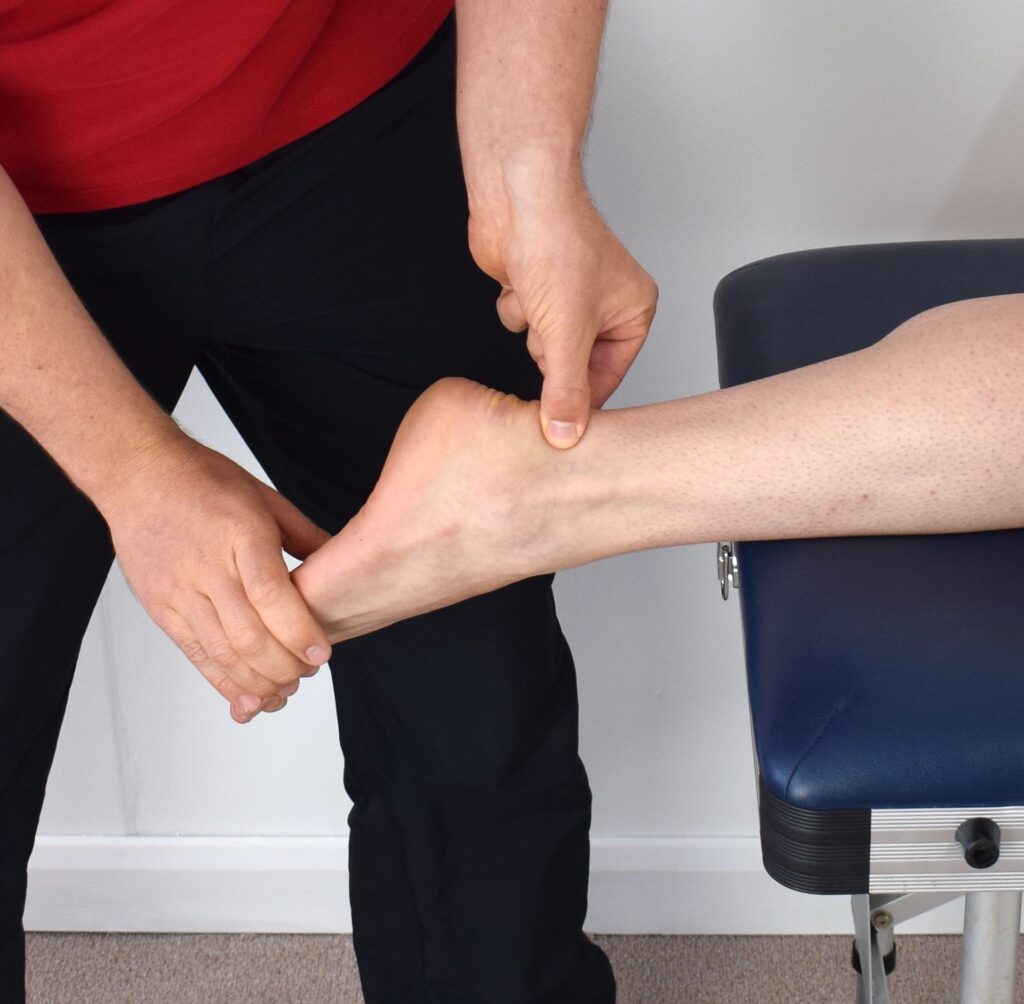Walking is good for Achilles tendonitis if it doesn’t further aggravate your symptoms.
Achilles tendonitis tends to present itself when you’ve done more activity than you’re used to particularly with running, hiking, sprinting, or walking.
As I was putting together this article I saw a few of the other search results and many of them were giving incorrect information, particularly, that you should potentially use a boot and immobilize the tendon to let it rest and heal.
The problem with completely resting this tendon is that you will weaken it and cause “stress shielding,” to occur which basically means that the tendon will become less elastic and more rigid.
I would almost never recommend booting the foot and ankle with this condition.
Instead, I’d follow this sequence in treatment:
- Rest 1-2 days
- Initiate a calf strengthening protocol using double-leg calf raises, single-leg calf raises, and banded plantarflexion as tolerated
- Use ice and/or heat to manage symptoms
- Use NSAIDs (as directed by your doctor), to manage symptoms
- Get back to your normal activity, walking, running, or hiking as soon as possible even if it’s only for short durations.
What we want to make sure of is to ensure that you are utilizing active recovery strategies as these will help you get back to full activity much faster than resting.
In the remainder of this article, I’ll discuss why extensive rest is not recommended for Achilles tendonitis or any tendonitis condition for that matter, and how to use a graded exercise program to increase your tolerance to walking and other activities.

Why is extensive rest not recommended for Achilles tendonitis?
Extensive rest is not recommended for Achilles tendonitis or other types of tendonitis because you will lose the thickness and tension of the tendon and you will lose muscle mass.
Losing the thickness and some tension from the tendon means you can’t produce as much force and it’s not quite as strong.
Similarly, when you rest for longer periods of time, you lose muscle mass and strength.
The problem with this is that most people then try to get back to their same level of activity with less strength of the tendon and muscle, which, inevitably leads to a reaggravation of the issue because you’re doing the same thing you did to cause the problem.
My recommendation is, as shared above, to participate in a graded exercise program nearly immediately after the pain has begun.
I will share a brief progression below.
What does a graded (gradual) exercise program look like for Achilles tendonitis?
First of all, please browse this article about how to modify an exercise program if you are having pain as it will teach you how to stay active while recovering from this issue.
The big takeaway from that article is:
- If it hurts a lot more a few hours later or the next day, you did too much.
- If you keep reducing how much you’re doing and it’s still bothering you too much, change the activity, exercise, or movement.
- Keep making adjustments, one variable at a time, until you have a program that works for you
- A program that works for you is one that challenges the tendon and muscle without making your symptoms significantly worse.
- A little increase in pain is okay, severe pain means you’ve pushed it too hard
Okay, now that we’ve got that out of the way, let’s go through a few exercises.
Double-leg calf raises
I recommend starting with these and to perform three sets of 10 repetitions. If you can do 3×10 very easily with no issue the next day, I’d recommend increasing it to 3×20. If there is still no problem, feel free to try single-leg calf raises.
Single Leg Calf Raises
These are more difficult however they are a great exercise, and one that if you weren’t already doing, regardless of your type of activity, you should be doing.
I would start doing this without weight for three sets of ten repetitions (3 x 10), and then progress to 3 x 25 as you are capable.
If you can do 3 x 25 with minimal discomfort then I would recommend adding weight. You can do this by holding a dumbbell, kettlebell, or something else in your hand.
For my single-leg calf raises, I usually add a 40 lb dumbbell to the hand on the same side of the ankle musculature I’d like to work.
Machine Calf Raises (seated)
You will likely need a gym for this one however I recommend the same set and rep scheme as above with three sets of ten. It’s easy to remember and you can always add weight with this machine if the initial weight you add is too easy.
Seated or Supine Plantarflexion
This would be the lowest level exercise. For this one, you’d grab a resistance band, loop it around the end of your foot making sure that it’s placed around the ball of your foot and then you should press down into the band.
Ensure there is enough tension in the band to create enough resistance where it feels challenging for ten repetitions.
Would Stretching Be Helpful For Achilles Tendonitis?
Stretching might be helpful to help relieve symptoms but generally, it is temporary.
Additionally, some people feel worse after stretching so you’ll just want to pay attention to your symptoms and what they feel like a few hours and 24 hours after you’ve stretched or worked out.
Make sure you just start with one stretch, too, as opposed to doing a bunch of stretches. If you do too many things you won’t know what working or what’s flaring it up and you’ll be left confused and irritated.
Don’t be that person!
